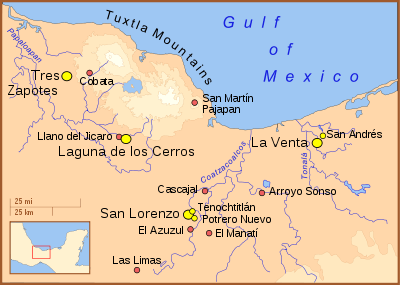Las Limas Monument 1
.jpg)
Las Limas Monument 1 is a 55 cm (22 in) greenstone figure of a youth holding a limp were-jaguar baby. Found in the Mexican state of Veracruz in the Olmec heartland, the statue is famous for its incised representations of Olmec supernaturals and is considered by some a "Rosetta stone" of Olmec religion.[1] The largest known greenstone sculpture,[2] it is also known as the Las Limas figure and the Señor de las Limas.
Interpretation
Sculptures of headdressed figures holding inert were-jaguar babies appear often in the Olmec archaeological record, from the smallest of figurines to the huge table-top thrones such as La Venta Altar 5.
What these sculptures symbolised to the Olmecs is not clear. Some researchers, focusing on the symbolic cave surrounding the figure on Altar 5 believe that these sculptures relate to myths of spiritual journeys or human origins. Others find that the limp depiction of the were-jaguar baby denotes child sacrifice.[3]




History
The statue is 55 cm (22 in) high, 42 cm (16 in) wide, and weighs an estimated 60 kg (132 lb). It was probably carved during the Middle Formative Period, some time between 1000 and 600 BCE).[5]
The statue was discovered in near Jesús Carranza, Veracruz, by two local children, Rosa and Severiano Paschal Manuel. Dug out and taken to their nearby home, it was declared the "La Virgen de las Limas" and set up on its own altar. Word of the find reached archaeologists in Xalapa. After promising to keep the statue on display — and to build a local school — the archaeologists moved the sculpture to the Xalapa Museum of Anthropology.[6]
Five years later, in October 1970, the statue was stolen from the museum, only later to be found in a motel room in San Antonio, Texas, apparently too famous to be sold on the black market.[7]
It is presently on display at the Museo de Antropología de Xalapa, in Veracruz.

Footnotes
References
- Coe, Michael D. (1968) Discovering the Olmec, American Heritage.
- "The Antiquities Market", in Journal of Field Archaeology, Vol. 1, No. 1/2 (1974), pp. 215–224.
- López Navarro, Raúl, "El Señor de las Limas", Actualidades Arqueológicas, Número 10 Enero-Febrero 1997. (Spanish)
- Joralemon, Peter David (1996) "In Search of the Olmec Cosmos: Reconstructing the World View of Mexico's First Civilization". In E. P. Benson and B. de la Fuente (eds.), Olmec Art of Ancient Mexico. Washington, D.C.: National Gallery of Art: 51-60. ISBN 0-89468-250-4.
- Miller, Mary Ellen (2001). The Art of Mesoamerica (3rd ed.). London: Thames & Hudson. ISBN 0-500-20345-8.
- Pool, Christopher (2007) Olmec Archaeology and Early Mesoamerica, Cambridge University Press, UK.
- Reilly, F. Kent (1995) "Olmec-style Iconography", Foundation for the Advancement of Mesoamerican Studies, Inc., accessed March 2007.
Further reading
- Joralemon, Peter David (1971) "A Study in Olmec Iconography", in Studies in Pre-Columbian Art and Archaeology No. 7, Dumbarton Oaks, Washington, D.C.